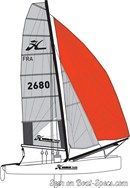Hobie Cat Tiger
Sailboat specifications
The Hobie Cat Tiger is a 18’1” (5.51m) double handed sport/beach catamaran designed by Hobie Cat Europe (France). She was built since 1995 (and now discontinued) by Hobie Cat (United States).
Hobie Cat Tiger's main features
- Model
- Hobie Cat Tiger
- Hull type
- Catamaran
- Category
- Double handed sport/beach catamaran
- Sailboat builder
- Sailboat designer
- Sailboat collection
- Country
- United States
- Construction
- GRP (glass reinforced polyester):
Sandwich foam fiberglass polyester - First built hull
- 1995
- Last built hull
- Discontinued
- Appendages
- Centerboard : twin daggerboards
- Helm
- Single tiller
- Rudder
- Twin transom hung rudders
- Unsinkable
- No
- Trailerable
- Yes
- EC design categoryiThe CE design category indicates the ability to cope with certain weather conditions (the sailboat is designed for these conditions)
A: Wind < force 9, Waves < 10m
B: Wind < force 8, Waves < 8m
C: Wind < force 6, Waves < 4m
D: Wind < force 4, Waves < 0,5m - C
- Standard public price ex. VAT (indicative only)
- N/A €
Hobie Cat Tiger's main dimensions
- Overall length
- 20’ 8”6.31 m
- Hull length
- 18’ 1”5.51 m
- Waterline length
- 17’ 10”5.42 m
- Beam (width)
- 8’ 6”2.6 m
- Draft
- 4’1.22 m
- Draft when appendages up
- 0’ 6”0.16 m
- Light displacement (MLC)
- 397 lb180 kg
- Capacity
- 529 lb240 kg
Hobie Cat Tiger's rig and sails
- Upwind sail area
- 228 ft²21.15 m²
- Downwind sail area
- 409 ft²38 m²
- Mainsail area
- 183 ft²17 m²
- Solent area
- 37 ft²3.45 m²
- Jib area
- 45 ft²4.15 m²
- Asymmetric spinnaker area
- 226 ft²21 m²
- IiFore triangle height (from mast foot to fore stay top attachment)
- 18’ 10”5.73 m
- PiMainsail hoist measurement (from tack to head)
- 28’8.53 m
- Rigging type
- Sloop Marconi fractional
- Mast configuration
- Fore beam stepped mast
- Rotating spars
- Yes
- Number of levels of spreaders
- 1
- Spreaders angle
- Swept-back (diamond)
- Spars construction
- Aluminum spars
- Standing rigging
- 1x19 strand wire continuous
Hobie Cat Tiger's performances
- Crew
- 2
- Trapezes
- 2 set(s)
- PY (Portsmouth Yardstick) ratingiPortsmouth Yardstick is an empirical rating system allowing small sailboats (dinghies included), of different sizes and designs, to race each other fairly. Therefore, by comparing these values, we can have an indication of the relative speed of 2 boats.
- 693
- Upwind sail area to displacementiThe ratio sail area to displacement is obtained by dividing the sail area by the boat's displaced volume to the power two-thirds.
The ratio sail area to displacement can be used to compare the relative sail plan of different sailboats no matter what their size.
Upwind: under 18 the ratio indicates a cruise oriented sailboat with limited performances especially in light wind, while over 25 it indicates a fast sailboat. - 714 ft²/T66.34 m²/T
- Downwind sail area to displacementiThe ratio sail area to displacement is obtained by dividing the sail area by the boat's displaced volume to the power two-thirds.
The ratio sail area to displacement can be used to compare the relative sail plan of different sailboats no matter what their size. - 1283 ft²/T119.2 m²/T
- Displacement-length ratio (DLR)iThe Displacement Length Ratio (DLR) is a figure that points out the boat's weight compared to its waterline length. The DLR is obtained by dividing the boat's displacement in tons by the cube of one one-hundredth of the waterline length (in feet).
The DLR can be used to compare the relative mass of different sailboats no matter what their length:
a DLR less than 180 is indicative of a really light sailboat (race boat made for planning), while a DLR greater than 300 is indicative of a heavy cruising sailboat. - 32
Hobie Cat Tiger's auxiliary engine
- Engine(s)
- No engine
Hobie Cat Tiger's accommodations and layout
- Cockpit
- No cockpit
Similar sailboats that may interest you:
Sailboats
First built hull
Hull length
2003
18’ 1”5.52 m
2015
15’ 5”4.7 m
2008
18’ 1”5.52 m
2008
18’5.48 m
2011
17’ 2”5.25 m
1969
16’ 7”5.05 m
2009
18’ 1”5.52 m
2002
17’ 2”5.25 m
1991
19’ 7”5.97 m
1998
20’6.1 m
1996
18’ 1”5.52 m
2002
18’ 1”5.52 m
1998
17’ 2”5.25 m
1987
21’ 4”6.48 m
1993
15’4.56 m






